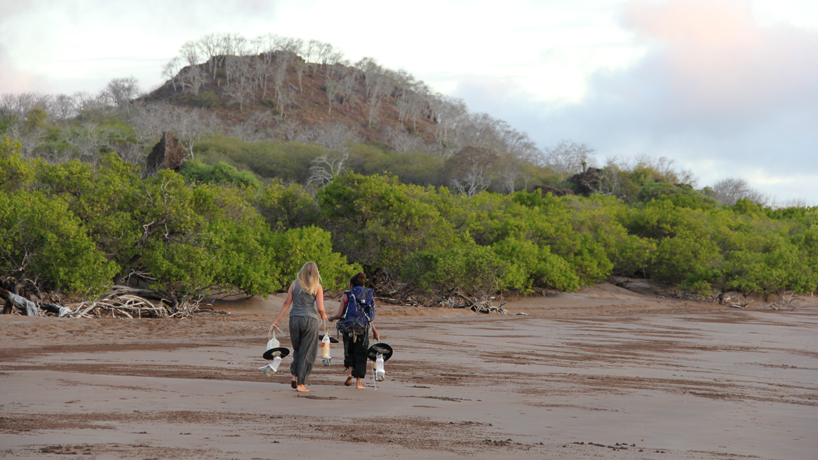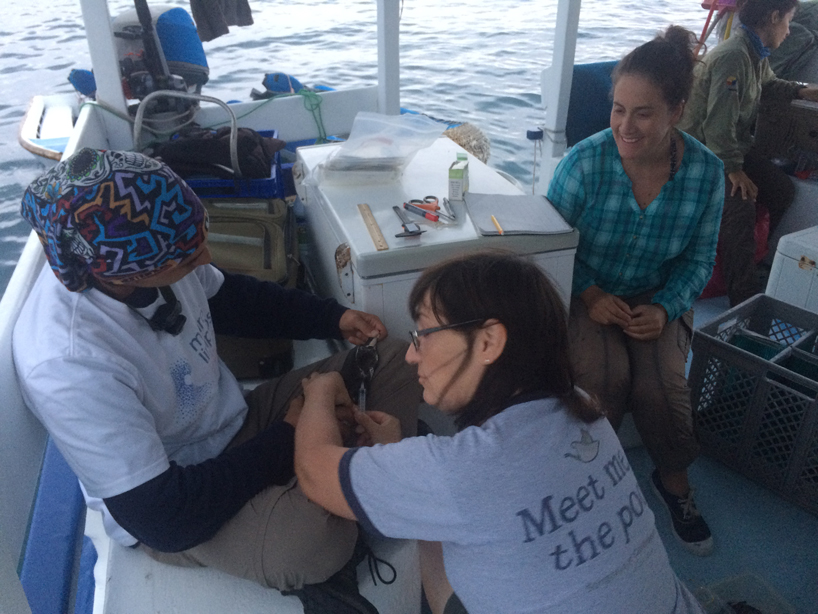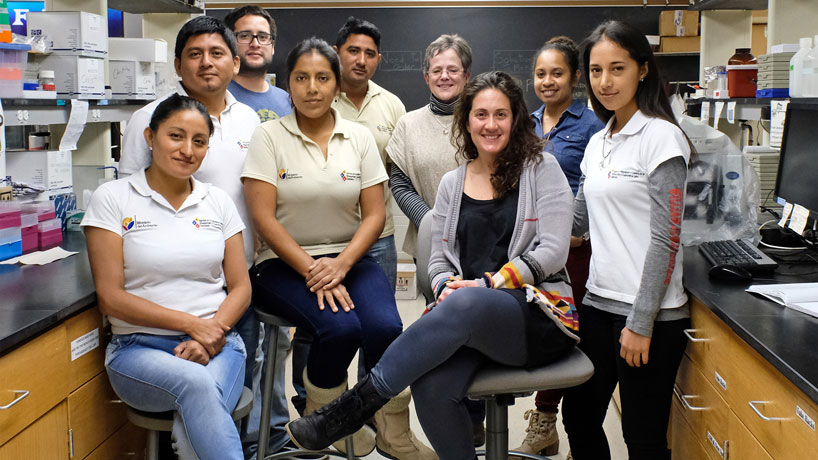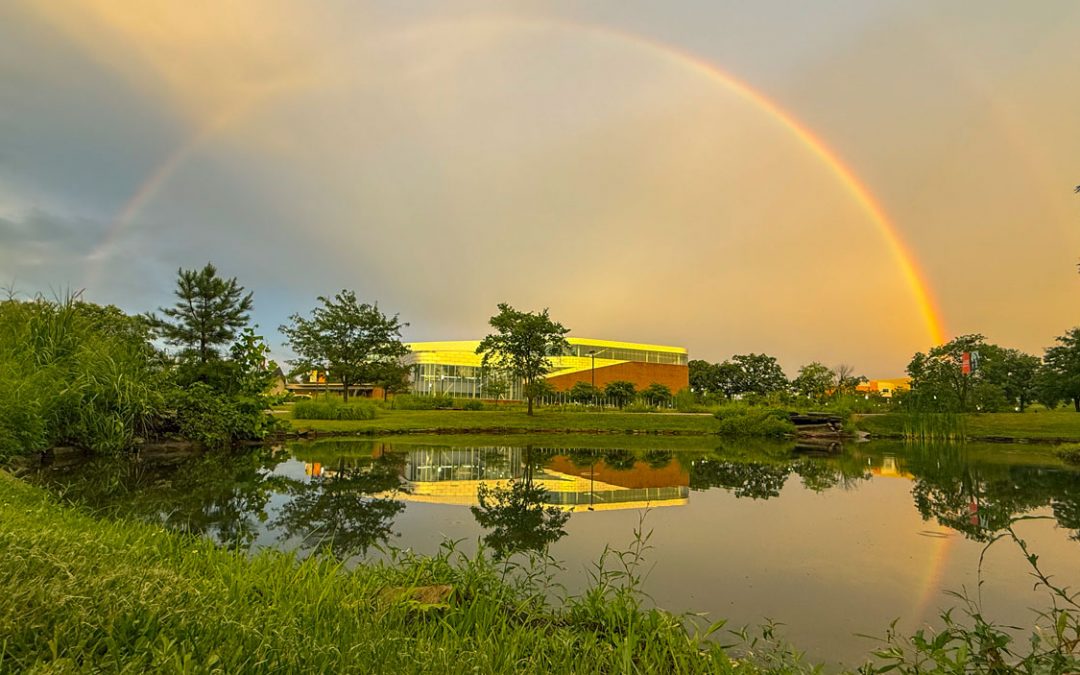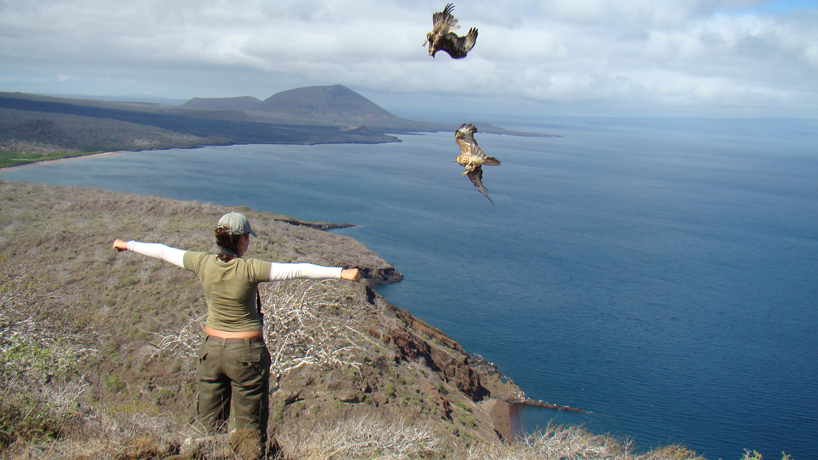
Mari Jaramillo, a native of Ecuador who earned both a master’s and a PhD at UMSL, observes two Galápagos hawks near the edge of a cliff on the island of Santiago. (Photo courtesy of Patricia Parker)
The Center for Avian Health in the Galápagos Islands was established through a more than two-decade collaboration between the University of Missouri–St. Louis, the Saint Louis Zoo WildCare Institute, the Charles Darwin Foundation and Ecuador’s Galápagos National Park.
Throughout that time, research done at the center has helped enhance the scientific community’s understanding of the health of the islands’ unique birds and worked to prevent their extinction.
Saint Louis Zoo WildCare Institute Executive Director Lisa Kelley is flanked by Saint Louis Zoo Director Michael Macek and Dana Brown President & CEO Dwight Scott as they show off the 2022 WAZA Conservation Award. (Photo courtesy of the Saint Louis Zoo)
The World Association of Zoos and Aquariums recently honored that fruitful collaboration by presenting it with the 2022 WAZA Conservation Award. The award, created in 2016, is WAZA’s highest honor recognizing institutional commitment to conservation.
“This award is especially meaningful to the St. Louis community because it reflects over 20 years of trusted collaboration between UMSL’s Whitney R. Harris World Ecology Center and the Saint Louis Zoo WildCare Institute,” said Lisa Kelley, the executive director of the Saint Louis Zoo WildCare Institute. “This partnership has resulted in over 30 advanced degrees for students representing numerous countries, many of which have gone on to be respected and productive conservationists in their own right, and two of which are employed at the Saint Louis Zoo.”
Patricia Parker, who retired in September as the E. Desmond Lee Professor of Zoological Studies in the Department of Biology, was instrumental in creating the center and guiding its growth.
Parker already had an established research program in the Galápagos, studying native hawks in the islands, in 2000 when she left her position as an associate professor at The Ohio State University and accepted the E. Desmond Lee professorship in St. Louis. But she wasn’t necessarily committed to continuing her research focus uninterrupted.
Her role at UMSL also came with an appointment as senior scientist at the Saint Louis Zoo.
Samoa Asigau, a PhD alumna, and Amanda Garrick, then an undergraduate student, set mosquito traps on the island of Santiago. (Photo courtesy of Patricia Parker)
“I spent the first six months talking to people at the Zoo about what they were doing in the different departments and then talking to people at UMSL about what they were doing and looking for points of connection to make it larger than me – points of connection where the institutions could have these joint interests,” Parker said. “This is what Des Lee wanted, right? He wanted institutions to work together at the institutional level. That’s what’s so great about this award. It’s not to me. It’s to the institutions.”
It was Eric Miller, then the head veterinarian who would go on to lead the WildCare Institute and become a senior vice president at the Zoo, who Parker remembers first floating an idea that brought together the Zoo’s strength in veterinary medicine and UMSL’s work in global conservation through what would become the Whitney R. Harris World Ecology Center. Using Parker’s connections in the Galápagos, he suggested starting a program to look at diseases, such as avian malaria and other pathogens, in the islands’ native wildlife, which historically has evolved in relative isolation from other parts of the world.
Parker and colleagues from the Zoo spent their first field season in the Galápagos in 2001, and their early research focused on albatrosses. But they quickly added additional species to study, doing work on most of the 50+ endemic bird species living on the major islands.
Jane Merkel, an UMSL alumna now working in zoological animal health at the Saint Louis Zoo, and Gustavo Jimenez, a collaborator from the Charles Darwin Research Station, process a penguin before release while on a boat off the island of Isabela. (Photo courtesy of Patricia Parker)
“All of this required the collaboration of the Galápagos National Park, of course, and the Charles Darwin Research Station,” Parker said. “We had a five-year memorandum of understanding that we just renewed every five years in this four-way collaboration. It was fantastic, and students could come in and really take a piece that was where their interests were and just go to town, and it’s in this iconic place.”
Over the past two decades, more than 40 UMSL students have participated in research projects in the Galápagos with the majority going on to receive master’s degrees and PhDs. Their work has led to well over 100 publications in scientific journals.
Parker helped create a book highlighting the research findings of many of the former students, and she served as the editor.
The research over the years, more importantly, has helped guide decisions made by the government of Ecuador in an effort to protect and preserve the wildlife living on the islands.
“All of it fit together,” Parker said, “to make this information that we could then give to the park so they could make good management decisions regarding minimizing the impact of disease.”
A group of lab technicians and veterinarians from Ecuador visited Patricia Parker’s lab at UMSL in 2017. (Photo by August Jennewein)
Throughout the collaboration, Parker and her colleagues at the Zoo have also worked intentionally to help build local research capacity in the Galápagos, helping train scientists from Ecuador to do the work in research and conservation so that they can manage the constant threat of outside diseases impacting the endemic populations.
In the spring of 2017, a team of Ecuadorian lab technicians and veterinarians visited UMSL’s campus, as well as labs at the Zoo and the veterinary diagnostic lab at the University of Missouri–Columbia. They learned lab protocols, techniques and methods used to test samples collected from animals and took those lessons with them back to the islands.
“It’s been a great run, and it’s thrilling that it got this recognition from WAZA,” Parker said. “The membership consists of nearly 400 leading institutions and organizations around the world, all dedicated to the care and conservation of animals and their habitats. This is a big deal.”


